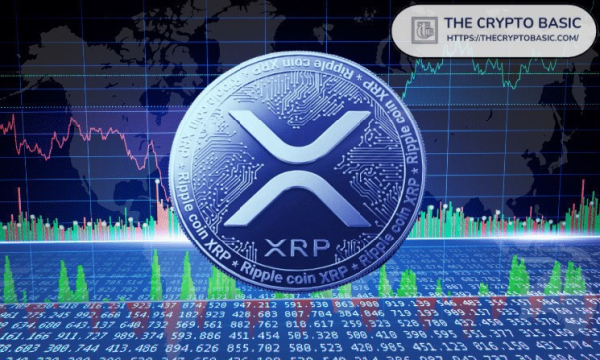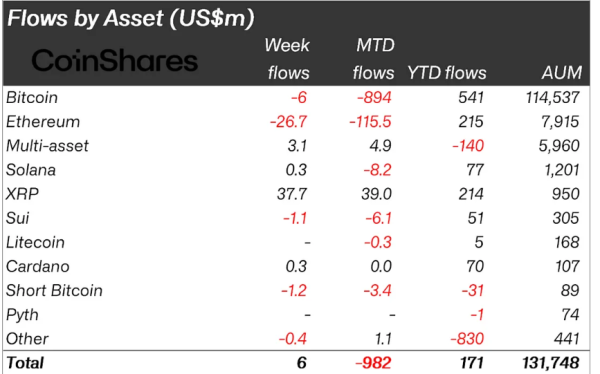How Long Until XRP Gets Its Own Strategy? Expert Reacts as Solana Receives $500M Investment

The XRP community is pondering the arrival of a strategy that invests in XRP, similar to what is available with other prominent crypto assets like Bitcoin and Solana.
Dom Kwok, Co-founder of EasyA Labs, expressed this perspective in a tweet. Specifically, he asked how long it will take until the crypto community sees an XRP strategy that commits to investing in the asset.
Kwok’s tweet came in response to an announcement by SOL Strategies, a Canadian investment company, about securing a $500 million convertible note facility to fund the purchase and staking of SOL tokens. The move marks the largest staking-yield-tied financing deal in the Solana ecosystem.
As part of the deal, SOL Strategies will initially draw $20 million by May 1, 2025. It has the option to access up to $480 million more over time. Interest on the notes will be paid in SOL, tied directly to staking returns, up to 85% of the generated yield.
Beyond SOL Strategies, DeFi Dev Corp (Janover) recently announced the acquisition of 88,164 SOL tokens worth $11.5 million for its crypto treasury strategy. This development came a few weeks after the firm made an earlier $4.6 million Solana investment.
1/ The $SOL stackin’ must carry on! 🚀
DeFi Dev Corp has purchased another 65,305 $SOL worth ~$9.9M as part of our crypto-forward treasury strategy.
This brings our total holdings to 317,273 $SOL, valued at approximately $48.2M (including staking rewards). pic.twitter.com/WC9Oqv3WwM
— DeFi Dev Corp (@defidevcorp) April 23, 2025
Given this massive investment entering the Solana ecosystem, XRP community members wonder when a similar initiative might emerge for XRP.
Already, many companies have adopted a Bitcoin strategy, following in the footsteps of Bitcoin firm Strategy (formerly MicroStrategy). These firms add BTC tokens as part of their financial investments through continuous acquisitions.
A specific example includes Metaplanet Inc., which just bought over $13 million worth of Bitcoin today, bringing its holdings to 5,000 BTC. Other Bitcoin-buying firms include GameStop and Rumble.
But Wen an XRP Strategy?
XRP enthusiasts eagerly look forward to a similar large-scale initiative, and one of their biggest hopes includes exchange-traded funds (ETFs). Several firms have already sought the SEC’s permission to list ETFs that would directly invest in XRP.
Recent reports suggest that such funds could take until the end of this year to go live, as the applications remain under review.
Notably, an XRP ETF recently launched in the U.S., but this fund, which is a leveraged product, does not directly invest in XRP. Instead, it capitalizes on XRP’s daily performance.
Meanwhile, outside of the U.S. market, funds investing in XRP exist, and these funds are attracting investments weekly. However, these investments are not as robust as what the U.S. market would witness.
Notably, the most recent investment report by CoinShares shows that XRP investments attracted $37.7 million last week. Interestingly, during the same period, Bitcoin investments reported a drain of $6 million. Ethereum investments posted more significant outflows of $26 million.

CoinShares chart showing XRP investment inflow
Proposal for XRP Strategy in Japan
Beyond ETFs, other significant financial institutions are receiving requests to adopt MicroStrategy’s Bitcoin investment style.
Recently, shareholder GAM Investments urged Japanese financial giant SBI Holdings to adopt an ambitious XRP-focused strategy. GAM proposed that SBI implement an XRP buyback program, similar to MicroStrategy’s Bitcoin accumulation approach.
GAM pointed out SBI’s market undervaluation, highlighting the hidden value of its crypto assets, particularly its substantial stake in Ripple and XRP holdings.
They also suggested that SBI’s underperformance is partly due to the lack of a clear strategy regarding its investments in Ripple and XRP. To address this, GAM recommended increased transparency, including daily valuations of its XRP holdings and regular updates on its net asset value (NAV).
 Bitcoin
Bitcoin  Ethereum
Ethereum  Tether
Tether  XRP
XRP  Solana
Solana  USDC
USDC  TRON
TRON  Lido Staked Ether
Lido Staked Ether  Dogecoin
Dogecoin  Figure Heloc
Figure Heloc  Cardano
Cardano  Bitcoin Cash
Bitcoin Cash  Wrapped stETH
Wrapped stETH  WhiteBIT Coin
WhiteBIT Coin  Wrapped Bitcoin
Wrapped Bitcoin  Wrapped eETH
Wrapped eETH  USDS
USDS  Chainlink
Chainlink  Binance Bridged USDT (BNB Smart Chain)
Binance Bridged USDT (BNB Smart Chain)  LEO Token
LEO Token  WETH
WETH  Monero
Monero  Zcash
Zcash  Stellar
Stellar  Sui
Sui  Coinbase Wrapped BTC
Coinbase Wrapped BTC  Hyperliquid
Hyperliquid  Ethena USDe
Ethena USDe  Litecoin
Litecoin  Avalanche
Avalanche  Hedera
Hedera  Shiba Inu
Shiba Inu  Canton
Canton  sUSDS
sUSDS  World Liberty Financial
World Liberty Financial  Toncoin
Toncoin  USDT0
USDT0  Dai
Dai  Cronos
Cronos  Uniswap
Uniswap  PayPal USD
PayPal USD  Polkadot
Polkadot  Ethena Staked USDe
Ethena Staked USDe  USD1
USD1  Mantle
Mantle  Rain
Rain  MemeCore
MemeCore  Pepe
Pepe  Bittensor
Bittensor  Aave
Aave  Bitget Token
Bitget Token  OKB
OKB  Tether Gold
Tether Gold  NEAR Protocol
NEAR Protocol  Falcon USD
Falcon USD  Ethereum Classic
Ethereum Classic  Jito Staked SOL
Jito Staked SOL  Binance-Peg WETH
Binance-Peg WETH  Ethena
Ethena  Internet Computer
Internet Computer  Aster
Aster  Pi Network
Pi Network  BlackRock USD Institutional Digital Liquidity Fund
BlackRock USD Institutional Digital Liquidity Fund  PAX Gold
PAX Gold  Worldcoin
Worldcoin  HTX DAO
HTX DAO  Jupiter Perpetuals Liquidity Provider Token
Jupiter Perpetuals Liquidity Provider Token  Global Dollar
Global Dollar  Circle USYC
Circle USYC  KuCoin
KuCoin  syrupUSDC
syrupUSDC  Binance Staked SOL
Binance Staked SOL  Sky
Sky  Aptos
Aptos  Pump.fun
Pump.fun  POL (ex-MATIC)
POL (ex-MATIC)  Ondo
Ondo  Ripple USD
Ripple USD  BFUSD
BFUSD  Midnight
Midnight  Rocket Pool ETH
Rocket Pool ETH  Wrapped BNB
Wrapped BNB  Binance Bridged USDC (BNB Smart Chain)
Binance Bridged USDC (BNB Smart Chain)  Arbitrum
Arbitrum  Algorand
Algorand  Gate
Gate  Render
Render  Cosmos Hub
Cosmos Hub  Filecoin
Filecoin  Quant
Quant  Official Trump
Official Trump  VeChain
VeChain  Bonk
Bonk  Bridged Wrapped Lido Staked Ether (Scroll)
Bridged Wrapped Lido Staked Ether (Scroll)  Function FBTC
Function FBTC  Lombard Staked BTC
Lombard Staked BTC  Solv Protocol BTC
Solv Protocol BTC  NEXO
NEXO  Janus Henderson Anemoy AAA CLO Fund
Janus Henderson Anemoy AAA CLO Fund  MYX Finance
MYX Finance  Liquid Staked ETH
Liquid Staked ETH  USDD
USDD  USDtb
USDtb  OUSG
OUSG  Sei
Sei  Mantle Staked Ether
Mantle Staked Ether  WrappedM by M^0
WrappedM by M^0  Pudgy Penguins
Pudgy Penguins  Superstate Short Duration U.S. Government Securities Fund (USTB)
Superstate Short Duration U.S. Government Securities Fund (USTB)  Arbitrum Bridged WBTC (Arbitrum One)
Arbitrum Bridged WBTC (Arbitrum One)  Polygon Bridged USDC (Polygon PoS)
Polygon Bridged USDC (Polygon PoS)  Lighter
Lighter  Renzo Restaked ETH
Renzo Restaked ETH  clBTC
clBTC  Virtuals Protocol
Virtuals Protocol  Wrapped Flare
Wrapped Flare  Jupiter
Jupiter  Story
Story  Ondo US Dollar Yield
Ondo US Dollar Yield  Beldex
Beldex  syrupUSDT
syrupUSDT  USDai
USDai  L2 Standard Bridged WETH (Base)
L2 Standard Bridged WETH (Base)  PancakeSwap
PancakeSwap  Stacks
Stacks  StakeWise Staked ETH
StakeWise Staked ETH  Artificial Superintelligence Alliance
Artificial Superintelligence Alliance  Jupiter Staked SOL
Jupiter Staked SOL  Polygon PoS Bridged DAI (Polygon POS)
Polygon PoS Bridged DAI (Polygon POS)  Optimism
Optimism  Kinetiq Staked HYPE
Kinetiq Staked HYPE  Tezos
Tezos  Curve DAO
Curve DAO  SPX6900
SPX6900  Spiko EU T-Bills Money Market Fund
Spiko EU T-Bills Money Market Fund  c8ntinuum
c8ntinuum  Usual USD
Usual USD  FLOKI
FLOKI  tBTC
tBTC  Lido DAO
Lido DAO  Injective
Injective  Dash
Dash  Arbitrum Bridged WETH (Arbitrum One)
Arbitrum Bridged WETH (Arbitrum One)  Aerodrome Finance
Aerodrome Finance  GTETH
GTETH  Ether.fi
Ether.fi  Celestia
Celestia  GHO
GHO  TrueUSD
TrueUSD  Marinade Staked SOL
Marinade Staked SOL  Stader ETHx
Stader ETHx  Ether.Fi Liquid ETH
Ether.Fi Liquid ETH  IOTA
IOTA  Starknet
Starknet  Wrapped ApeCoin
Wrapped ApeCoin  Chiliz
Chiliz  The Graph
The Graph  JasmyCoin
JasmyCoin  BitTorrent
BitTorrent  Fartcoin
Fartcoin  JUST
JUST  AB
AB  Maple Finance
Maple Finance  sBTC
sBTC  Staked Aave
Staked Aave  Ethereum Name Service
Ethereum Name Service  DoubleZero
DoubleZero  Coinbase Wrapped Staked ETH
Coinbase Wrapped Staked ETH  Conflux
Conflux  Pyth Network
Pyth Network  dogwifhat
dogwifhat  Kaia
Kaia  Bitcoin SV
Bitcoin SV  Sun Token
Sun Token  Steakhouse USDC Morpho Vault
Steakhouse USDC Morpho Vault  Trust Wallet
Trust Wallet  Binance-Peg Dogecoin
Binance-Peg Dogecoin  Plasma
Plasma  ether.fi Staked ETH
ether.fi Staked ETH  Telcoin
Telcoin  Wrapped STX (Velar)
Wrapped STX (Velar)  Gnosis
Gnosis  Pendle
Pendle  crvUSD
crvUSD  AINFT
AINFT  EURC
EURC  Olympus
Olympus  Avalanche Bridged BTC (Avalanche)
Avalanche Bridged BTC (Avalanche)  Cap USD
Cap USD 